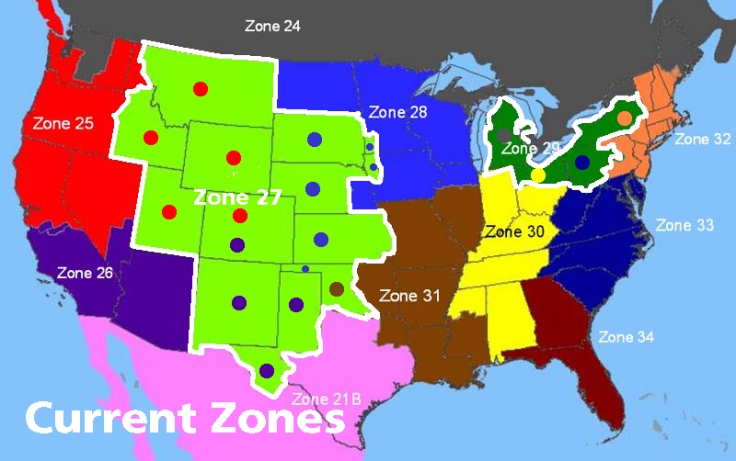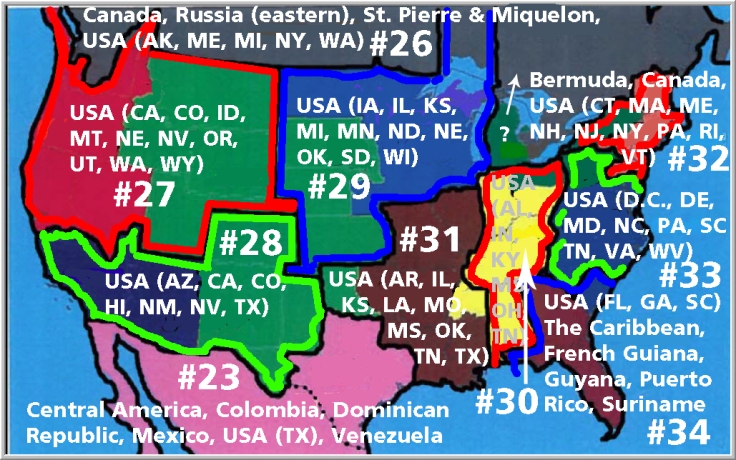America will lose two Zones & likely one director in 2020
by John Borst, PP Rotary Club of Dryden, ON
Imagine being given the task of realigning Rotary’s Zones with both hands being tied behind your back. That is the task that Rotary’s Zones Review Committee (ZRC) was given. At its January 2017 meeting, the Rotary International Board of Directors adopted a new zone structure as recommended by the ZRC.
First some brief background facts:
- Rotary has 34 Zones throughout the World
- Each Zone is comprised of Districts and has about the same number of Rotarians
- North America, Europe & Australia numbers have declined, Asia, Africa, & India increased
- Bylaw 010.4.calls for periodic reviews, last done in 2008
- 3 Regional workgroups were formed Asia, Europe/Africa, and the Americas
- ZRC task to reduce North America by 2 Zones & increase Asia, Africa & India by 2
Rotary President John F. Germ admits “Rezoning is always an emotional subject for some Rotarians…” and goes on to say “…“the workgroups and Board acted courageously in an effort to be fair to all concerned.”
History provides many examples of how boundary disputes have led to unfortunate results, even wars. The study of boundaries is called geopolitics, which is a combination of geography and politics. I mention this latter fact because geography attempts to express a political decision in a spatial way in a form we call, maps.
Constraints placed on the Regional Workgroups and the ZRC
- The 34 Zones had to remain because adding 2 would have required approval of the Council on Legislation
- Therefore the ZRC’s mandate was to reduce North America by 2 Zones & increase Asia, Africa & India by 2
- The ZRC and Regional Workgroups do not appear to have had the authority to adjust District boundaries in the establishment new Zones. This is unfortunate because the two are interrelated.
The Impact and Realignment of Zones in North America
- The two zones which were eliminated are Zone 27 and Zone 29.
Map of Current Zones and Annexation Distribution

Zone 27’s redistribution using the current Zone numbers:
- The red dots – States of Montana, Wyoming, Utah, remainder of Idaho, and the north part of Colorado were annexed to Zone 25;
- The purple dots – State of New Mexico, southern part of Colorado and Northwestern area of Texas were annexed to Zone 26;
- The blue dots – Sates of South Dakota, Nebraska, Kansas, corners of Minnesota & Iowa plus a tiny sliver of Oklahoma were annexed to Zone 28;
- The brown dot represents a portion of Oklahoma annexed to Zone 31
Zone 29’s redistribution using the current Zone numbers:
- The dark grey dot is the majority of Michigan annexed to Zone 24
- The yellow dot is northern Ohio annexed to Zone 30
- The dark blue dot is western Pennsylvania annexed to Zone 33
- The orange dot is southern 7 eastern New York State annexed to Zone 32
Map of the 2020 Zones and Numbers

The New Numbering System
|
CURRENT ZONE NUMBER |
2020 ZONE NUMBER |
|
21 |
23 |
|
24 |
26 |
|
25 |
27 |
|
26 |
28 |
|
27 |
ELIMINATED |
|
28 |
29 |
|
29 |
ELIMINATED |
|
30 |
30 |
| 31 |
31 |
| 32 |
32 |
| 33 |
33 |
| 34 |
34 |
As can be seen, five Zones will retain their number and five Zones will have a new number.
The Issue of Transparency
The first thing I did when I read the press release on this initiative was to go looking for a map. Eventually, I found two at the Zone 28-29 website. My maps above are based on them.
Zone 28 – 29 has considerably more background including who voted against this proposal, who abstained and who voted for it as the vote was recorded. They also did an analysis of the equality of members by zone, the result of which is on their map (see Zone Realignment Projected View) and which is the picture at the head of this post.
RI’s website under MY Rotary only had a .xls file for download, which only listed the States, without the districts. The States as compiled on the 2020 map above and were drawn from that document.
To find the Districts listed for the 2020 Zones you have to look at Appendix G of the January 2017 minutes.
Conclusions
As RI president John Germ says ““Rezoning is always an emotional subject for some Rotarians…” There is no excuse for the lack of maps when boundaries are being redrawn. Rotary should immediately commission quality maps in PDF format detailing all of the 2020 Zones so Rotarians can see the Worldwide picture.
Since Rotary’s Board of Directors membership is determined and set by the distribution of pairs of Zones then in 2020 there will be one less American/Canadian on the Board.
Rotary is already reeling from the impact of its decision to implement Policy 2.100 seen by many American Rotarians as a rejection of American values and culture and a politicisation of the organisation in their eyes.
What this realignment does, at this time in Rotary’s history, is emphasise the continued rebalancing not only of the geographic redistribution of members but of power and influence being transferred from the European-North American axis to the Asia-India-Africa axis.
Given the current political state of America, one has to wonder if Rotary International will, in the not too distant future, face a crisis within “Rotary America”.
Finally to quote Zone 28-29 “There are many unanswered questions at this point. The next step it to devise the implementation plan. The Zone Review Committee will be looking at other issues such as Zone pairings and Director Election rotation for the June board meeting.”




May 10, 2017 at 10:20 am
Bravo, John, a solid piece! Thanks for making this public, particularly at this moment in time.
LikeLike
May 11, 2017 at 6:59 pm
True and well said!
LikeLike
May 12, 2017 at 3:59 am
Who really cares about zones and the balance of geographic power! Aren’t we all part of one organization called Rotary. I don’t say I belong to Rotary Zone #. I am a Rotarian part of my club and a global org named Rotary. All other boundaries are ridiculous. Rotarys board should have eliminated zones and districts. That would be a wow moment.
LikeLike
May 12, 2017 at 9:22 pm
Zones are made to form RI board of directors 17 plus 17 … this is why every year we get a new president from a different zone …
LikeLike
May 15, 2017 at 8:25 pm
If the location of the membership is changing should not the representation in RI leadership change? I do not know, because because we have not fully identified controlling factors. By the very nature of its mission, RI is composed of “giver” areas and “receiver” areas. Do the givers have a larger voice and how the funds are used or do those with the needs determine it? We need to answer that question carefully.
The contributions from the “giver” areas seem to be starting to decline. If this is so and it is because of losing determination of where/how funds will be distributed, we walk a delicate line.
I have seen many article about problems in appropriate usage of funds in receiver countries and yet this action increases leverage.
Maybe pure democracy is the way: largest count wins. Still, if the providers decide it is unfair they will stop providing and that leaves the majority with much less to distribute. My logic says if this happens the losses will accelerate.
We have a true conundrum. There is much discussion needed. Few organizations last over 100 years. We need to be caution to enable Rotary to be one that does.
LikeLike
May 18, 2017 at 8:41 pm
The division of California’s Central Valley into tow different zones makes absolutely no sense! The Central Valley has common social-economic, political and agricultural issues–along with a long Rotary history of being in the same zone!
LikeLike
May 18, 2017 at 9:29 pm
Bruce, this is just a numbers game. That is the only thing that has to make sense. I will give the folks who did this some credit in that it is a hard job that probably doesn’t have any solution that doesn’t hurt somewhere. Too bad a better membership plan was created for the US back in the day. As power continues to shift away from Rotary US, the world of Rotary will shift with it. Us Rotarians need to start thinking about what that will mean for the organization we founded and love so dearly.
LikeLike
May 18, 2017 at 11:06 pm
Ken and Bruce, I agree, this is mostly a numbers game. It might interest you to know I had a board member contacted me about the approach I took. This was done with an exchange of emails. I also had a past district governor approach me in person, about my approach. Both felt I had been too negative and the DG too sympathetic to the position of the USA.
The director told me as a result of the post disrespectful calls/emails had been received. It was also described as the hardest decision faced to date.
I do think US Rotarians need to seriously consider the implications of this trend, which I believe will continue and how they might wish to respond. Steve Sokol makes many good points.
LikeLike